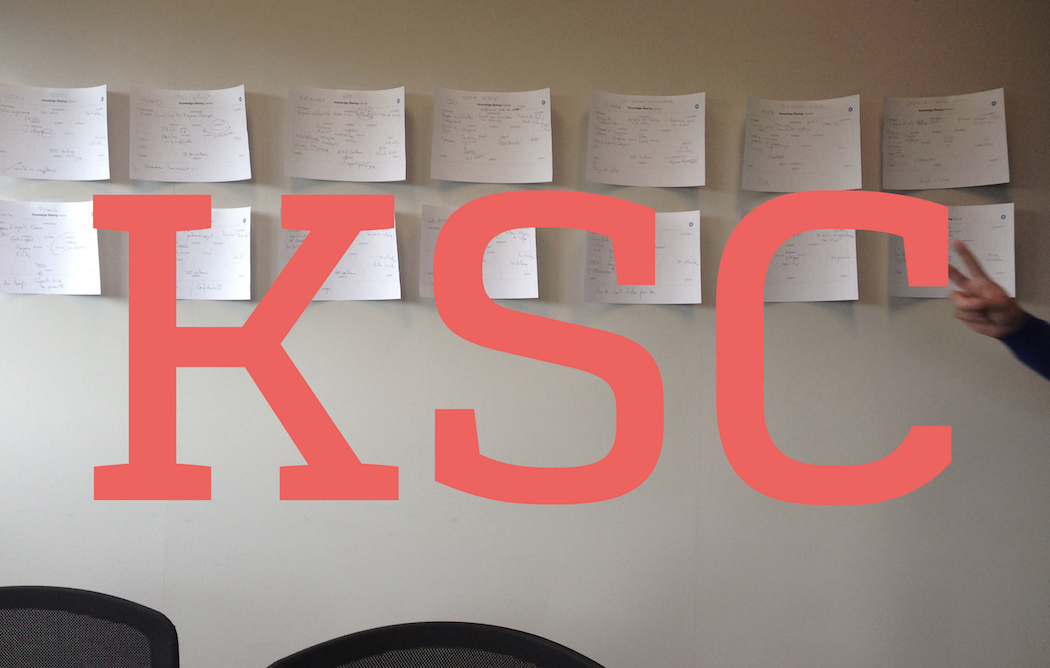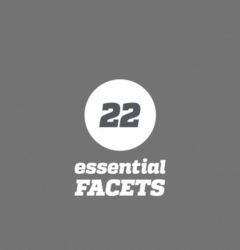31 Oct

### This interview was conducted by Ana Neves for Knowman to understand the creation process behind the Knowledge Sharing Canvas designed by Raphael Briner.
** Ana Neves : In an article, you describe the Knowledge Sharing Canvas as “an accessible, efficient and participatory toolkit for knowledge enthusiasts to succeed in analysing, designing, developing, implementing and evaluating a Knowledge Sharing Network”. What do you consider to be a Knowledge Sharing Network? What are its main components?**
Raphaël Briner: Knowledge Sharing Networks are very inclusive; first, all Enterprise Social Networks, Intranets, Collaboration platforms. I do even consider a conference as being a knowledge sharing network. The event offers explicit contexts and challenges. Speakers come with stories to demonstrate their reflections and the audience is using Twitter as a backchannel to give positive and negative signals. The KSC was designed to include the physical world in the journey of knowledge mapping. Facebook is definitely one of the largest knowledge sharing networks. Contexts, mainly topics, are morphing according to worldwide news and epic personal times. Most people understand that personal stories generate a better reach than simple links in the top feed. Stories put information in context and engage people beyond likes. They help people understand the motivation behind the publication and why it is relevant. Of course, a picture is a beautiful story! In our personal life, we choose Facebook over other networks because we know that we will have a broader attention. The success of the likes lies into the power of explicit attention.
All organizations have a knowledge sharing activity. This kind of sharing activity is just more complex and distributed than the one arising out of a conference. The more explicit it is, the more you outperform your competitors on your customer journey, innovation and operations. I have no doubt that Amazon, Tesla, Airbnb and all amazing startups in the world are quickly building a strong and shared intellectual capital, even publicly. In this quest for relevance and improvement of Employee and/or Customer experience, there is a real interest in organising meetings with colleagues and partners to determine how your company is able to foster a culture of knowledge (not only innovation), to define aspects such as the scope, roles, tools, ideas, drivers and issues… That’s exactly the purpose of the KSC. To use it in order to structure your conversations and facilitate common understanding of a global situation.
It will help define:
- The existing Challenges such as silos, information overload
- The desired Outcomes such as performance, excellence
- The Givers and the Takers, which might be the same
- The way users organise content (Contexts) such as groups, projects and communities
- The amount of Relations including tags and meta-datas
- The type of Stories such as status updates, meeting minutes, incidents, personal reflections
- The amount and type of Feedback such as comments, likes, validations
- The amount of Attention,including absorption capacity and acknowledgement
- The various (user) Experiences/Enablers such as mobile interface, newsletters acting as sharing enabling environnements
- The available knowledge Assets such as sleeping document databases
AN: Do you believe in creating knowledge sharing networks or in nurturing them? (I.e. is it possible to create them? Or should you aim to identify them and nurture them?)
RB: Knowledge sharing networks already exist in all companies except that they are not all digital… yet. Should this knowledge be centralized or distributed, are the knowledge sharing tools utilized to their full potential or not? In our experiences, our clients are migrating users from older platforms, success depends on the purpose and the energy of the people in charge (Euan Semple, 2014). Moving assets, directories, databases is not an issue. Moving people neither, if the new experience is exciting and promising. The same goes for real life.
For instance, the Web Summit is moving from Dublin to Lisbon. New speakers, new challenges, new topics and a redefined network, including sub-networks. And most definitely a new experience. My friend Laurent Haug, founder of Lift Conference confided that the most difficult thing is to keep a network fresh and energized after the early years. Quality versus quantity is a universal challenge, always related to manday resources and now algorithms and automation. The Web Summit did an amazing newsletter work, including targeted and personalized messages. From 1’000 attendees, they now have more than 30’000 attendees, thrilled to go to Lisbon! Brilliant nurturing supported by a simple promise: “They will be there, will you ?”
**AN: The KSC considersRelationsand Attentionto be the ultimate level. What is so important about those two elements? **
RB: How you balance these two elements will define how successful your project will be. Asking to put in Relationstoo many pieces of content, for instance with 20 mandatory tags on each document, will reduce engagement by generating too much friction on contributions. Asking for too much Attention, for instance with a daily newsletter, will also reduce engagement by creating too much noise for users. This is clearly a question of governance and notifications management. The onboarding success of enterprise social networks relies into a simple implicit premise: you will perceive a company-wide Attention. Years ago with a classical ECM (Lee Bryant, 2015) or intranet approach, it was impossible to achieve because there was no smart notification and conversation systems. I can see many projects still experimenting with how to reach employees and engage them, testing how to make it sustainable, make the case for knowledge reuse and turn the flow into knowledge assets, with relevance.
I strongly believe knowledge sharing is the first key vector in our challenge to embrace change. As far as I’m concerned, it comes down to a good balance of weekly stories, daily check-in/check-out and findings, and monthly design-thinking meetings. This will help reducing the number or the length of meetings to highlight human and digital instead (Bayron, 2015). It means the way to get attention (and recognition) needs to be reinvented.
AN: How and when do you envision the KSC being used? And by whom (hierarchical level and role type/department)?
RB: I knew from day one that I should make it universal: that is why I left The Knowledge Plaza ecosystem aside.I’m addressing any academic, institution and society in the world, who can use such a map to find answers on:
- What are the key components of a Knowledge Sharing network
- What’s going well
- What should be improved
- What are the brakes, drivers, triggers
HR, Innovation, sales managers, any leader can use the canvas for themselves, for a workshop, for a case study. We all have a more or less active knowledge sharing flow.
** AN: You created the KSC within the context of the work you do at Knowledge Plaza, a knowledge sharing platform. Why did you believe it seemed important to come up with a tool like this one? **
RB: When I started designing the KSC, I didn’t have a personal objective, just a very clear inspiration in a dynamic environment. I was lucky to spend 6 months in Manchester, observing HyperIsland, an amazing school focusing on digital transformation and experience, using other human-centered tools, models & methods such as the Double Diamond, Design Kit, etc. I realized then that in my own field, a canvas was missing. So I went to design it and I tried to make it memorable. At the first presentation within my company, I explained this map could be used at each level of the organisation. I put myself in other people’s shoes and I had a usecase for each team. The KSC was quickly supported by my colleagues. I then wrote a serie of key questions and examples for each building block, based on my own experience and readings.
After months of reflections, tests with unknown managers and project owners, +20 workshops in 10 cities all around Europe, I can say that the first design iteration was appropriate and matched a variety of different teams needs (KM, HR, Strategy, Collaboration and Internal Communication). For example, our product roadmap around Knowledge Plaza is influenced by the canvas.
Additionally, while working at Impact Hub Geneva (a coworking space), I was asked to introduce the canvas to two directors of WWF. They were launching a disruptive project with a new business model within the organization. In 30 minutes, their KSC were fully filled with their own reflections and they understood how far knowledge could help them acquire more projects, more resources, and get more support from the entire WWF. Above all, they realized that knowledge sharing would make the difference in the field and within the company itself. The KSC helped them realize by themselves all those points in one workshop! Strategic-thinking and facilitation, both organised around a concept model, are simply an amazing way to kick start and handle any project.
**AN: Why did you feel the need to create a pen and paper instrument to guide a reflection around something which is increasingly digital? **
RB: We all have that dream of an internal or external social network that grow and evolve naturally, remotely. Meanwhile physical meetings are still critical to align a group of people on strategic actions and understandings. The advantage of a pen and paper tool is this capacity to enable the team through a reflective task. This visual format catalyzes thought processes. With the KSC and any Design Thinking canvas, we have the ability to share a mental pattern of thought, enabling participants to map visually in front of them complex answers and understand the circular process of knowledge sharing. Also, Strategic & Design Thinking are now seriously adopted by 21st Century Businesses. They want accelerators to diverge and converge together. They know that they are facing something ambiguous, social, highly inclusive, with different paths to support fast-changing internal processes, that might be re-designed at any moment -thanks to new voices- on a daily basis. Sometimes, the canvas acts as a simple artefact of their internal networks and people are happy to have something in their hands, even if it stays blank.
Interview mode with Peter Latham Join The Dots
**AN: Can you share one or two stories of “ahah” moments (at KP or preferably a client) taking place as a consequence of using the KSC? (ahah moments = revelations) **
RB: We have several advertising and research agencies as clients. One of them is based in Manchester and I was lucky to conduct an interview on their usage of our platform. We started the interview with the KSC and I was very surprised how well it helped him to structure his thinking. We could both have a better and shared understanding of his use case, above all on the WHY and WHO. At the last Users Club in Paris, I invited 25 Knowledge Plaza clients to map with neutral questions what they are doing well on their networks, what could be improved, what issues they’re facing. We got more than 100 post-its in 10 minutes. Thanks to the formalized annotations, I could sort them in a very structured way.
I found the answers very strategic and it helped me to see that our clients were facing serious cultural challenges and that they wanted the Knowledge Sharing Canvas to have more “strategic-planning” questions. It helped me to accept that culture, collaboration and knowledge sharing are fundamentally intertwined. The direct consequence of this workshop are two complementary tools:
- The Double X, a reflective tool and open research to use collaboration to map collaboration, with one unique neutral question: What are your needs to master collaboration?
- The 6R (Reasons, Rules, Rights, Roles, Roadmap, Rhythm) to define the next steps for each building block of the KSC using a Diverging/Converging thinking, and satisfy the strategic-planning requirements in an unpredictable network.
**AN: I assume that you would encourage your clients to use the KSC in order to better define the structure of their Knowledge Plaza platform. Can you give us a few examples of how you map the answers in the KSC with the way you set up Knowledge Plaza for them? **
RB: We are currently weaving in the KSC into our Customer Success program, called ADOPT. It is now part of our induction day. It fitted in just right, as we didn’t have any facilitation methodology until now. My colleagues use it to have a better conversation on the core strategy, share a common language and map, and structure key answers. You can’t go into too much detail which is a good thing to stay high-level
For the planning part, they use mainly a classic calendar view for the deployment which is around 2-3 months.
As for any workshop, they take pictures of the walls and rewrite everything. All those informations are then shared with all stakeholders and involved parties, within a private space on our extranet. I definitely recommend any of our clients to go through the KSC at least as a checklist. “Left-brain” people as known as Information Architects will see that they put their energy into the left part of the canvas (Contextualization, Assetsand Relations) and “Right-brain” people as known as Internal Communication Managers will see that they focus a lot on the communication and collaboration side (Stories, Attention, Feedback).






